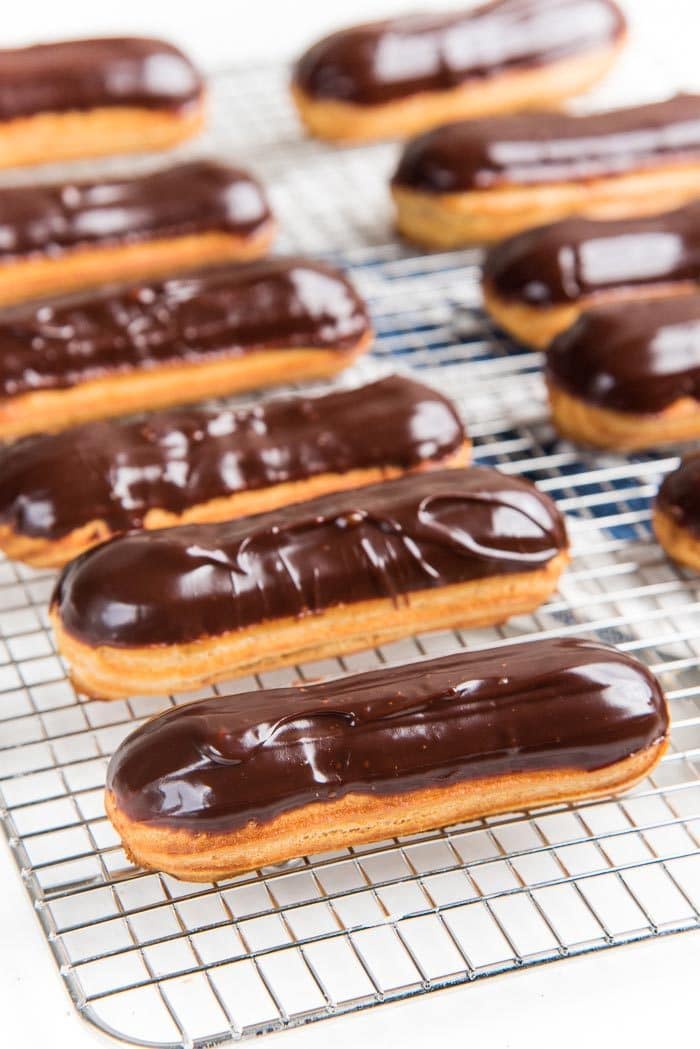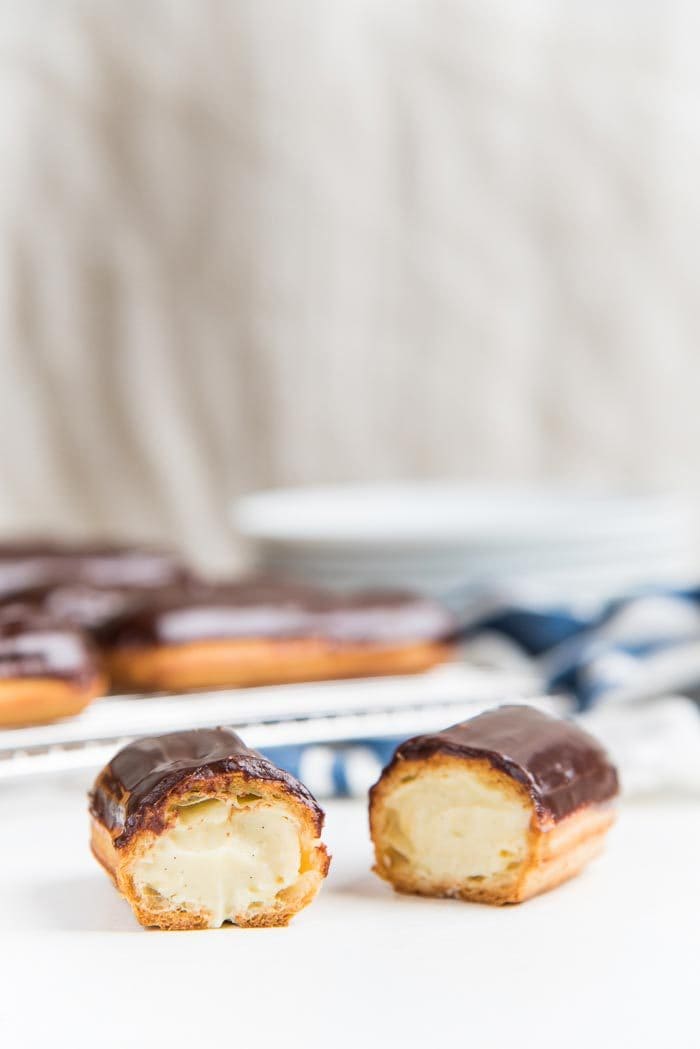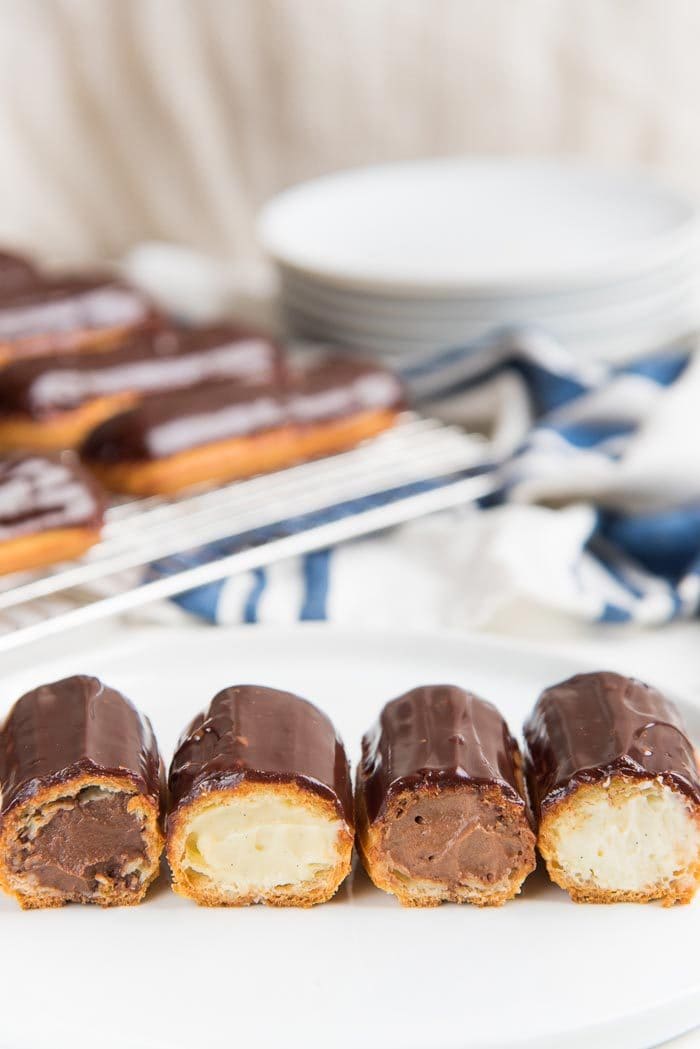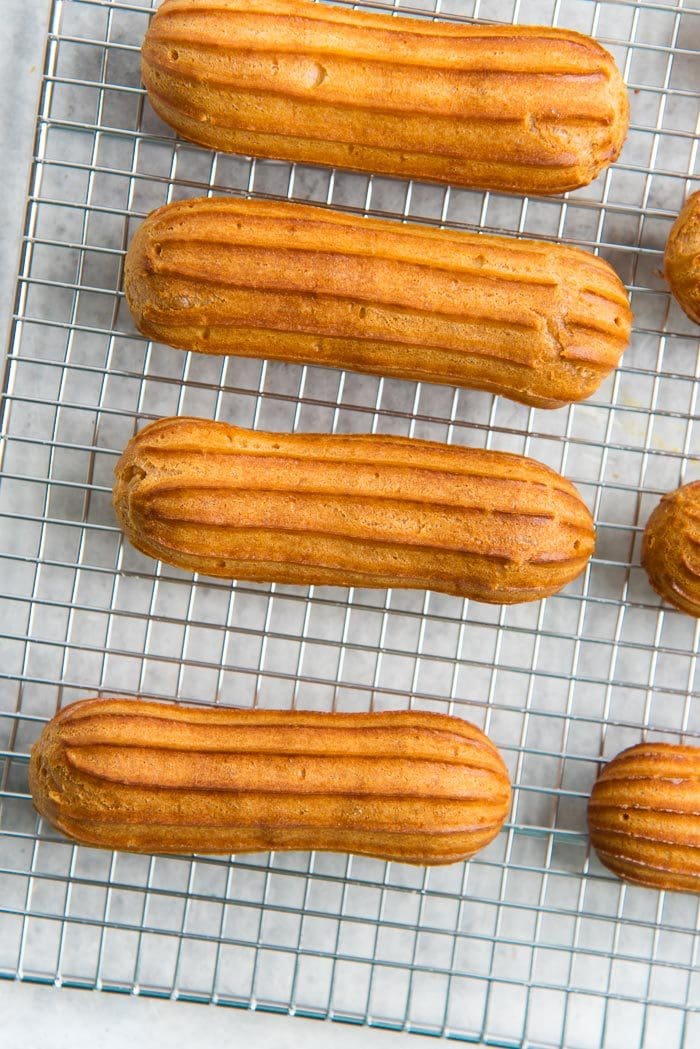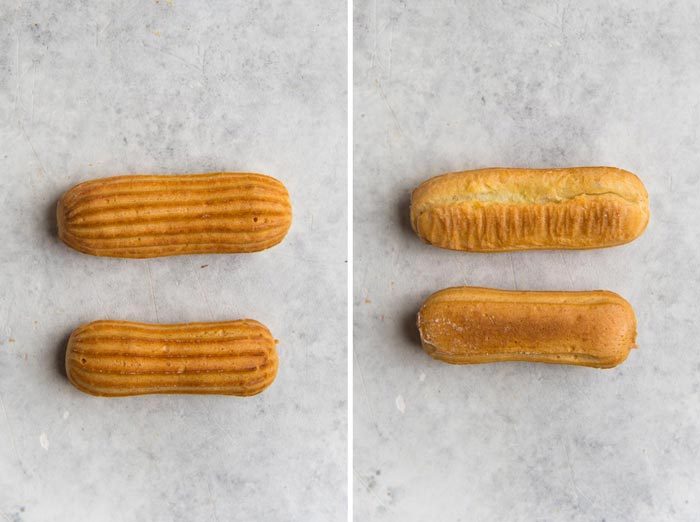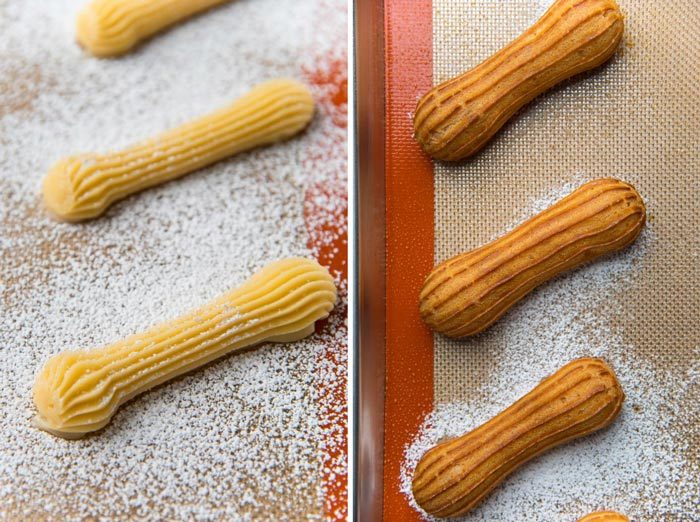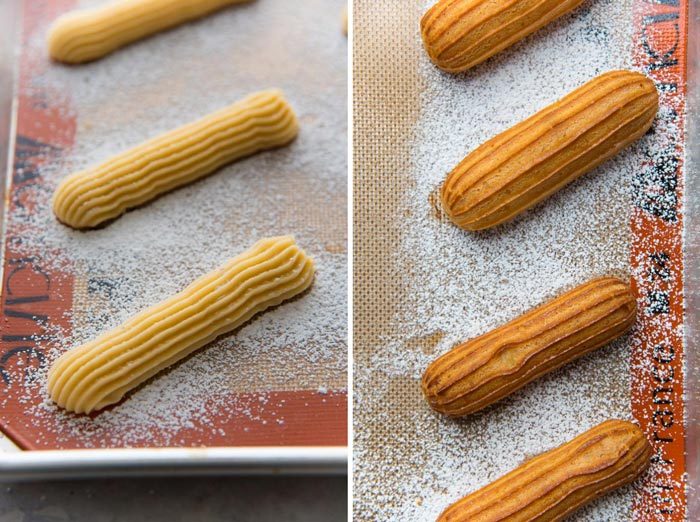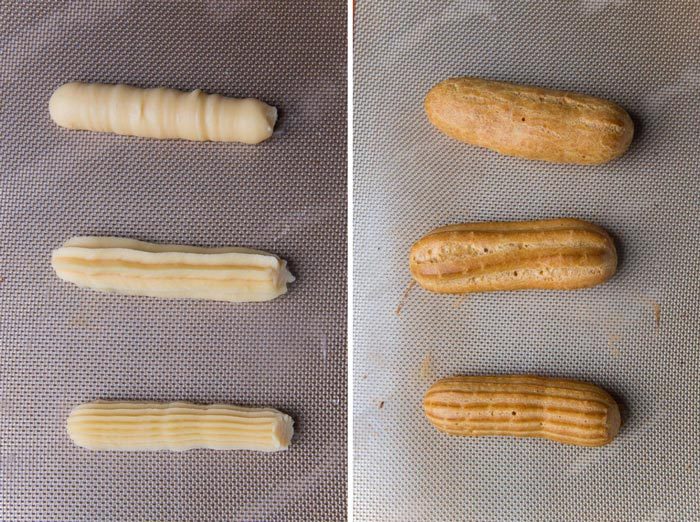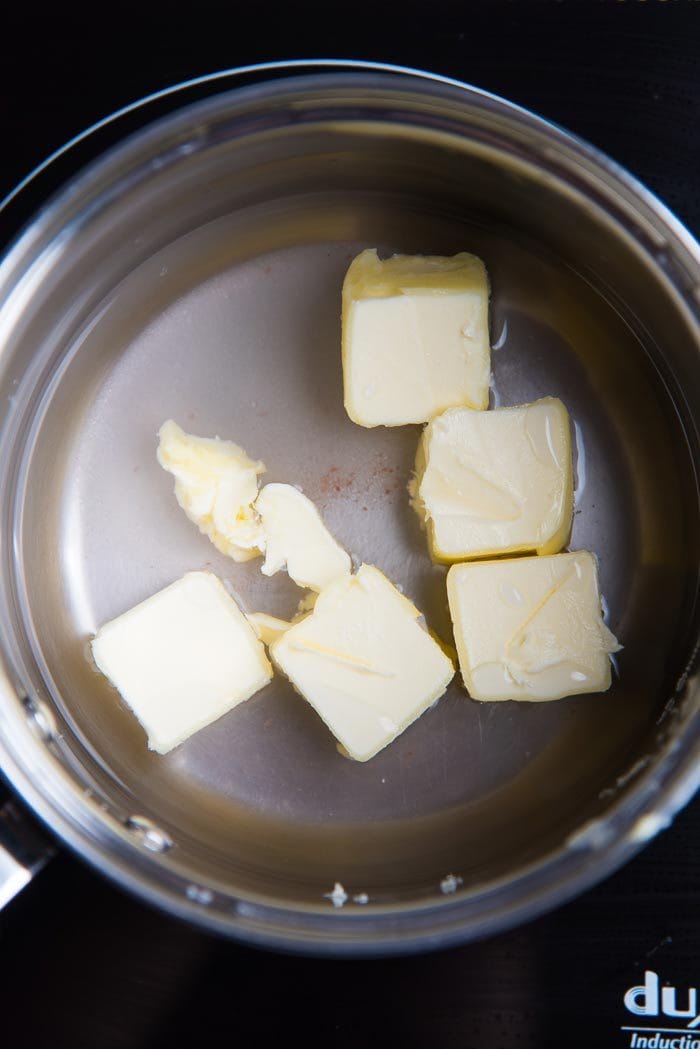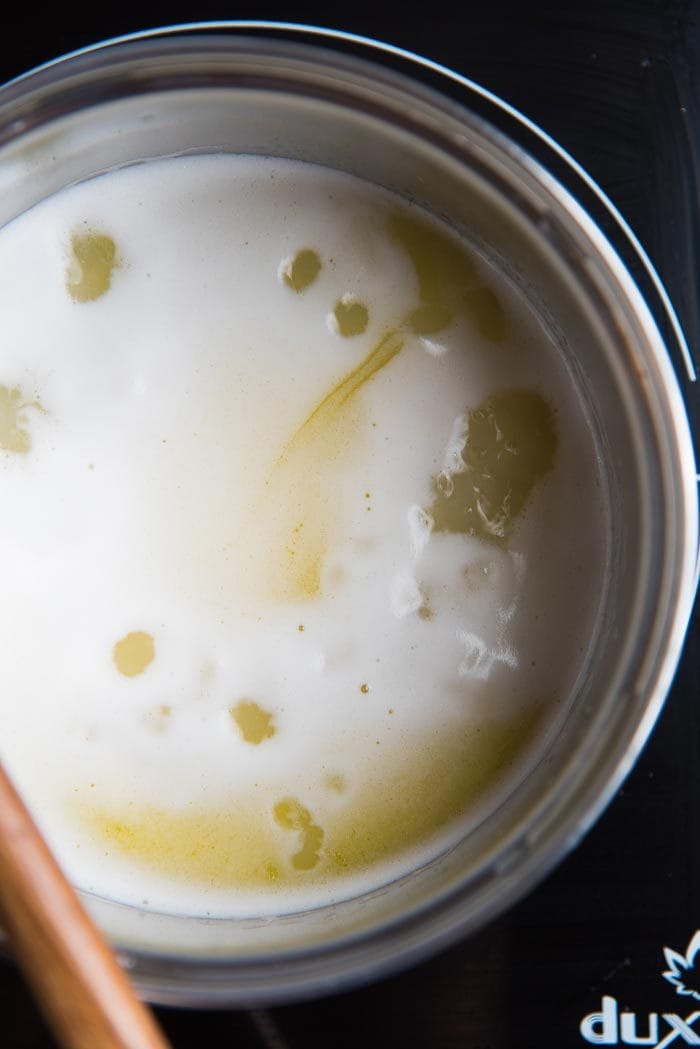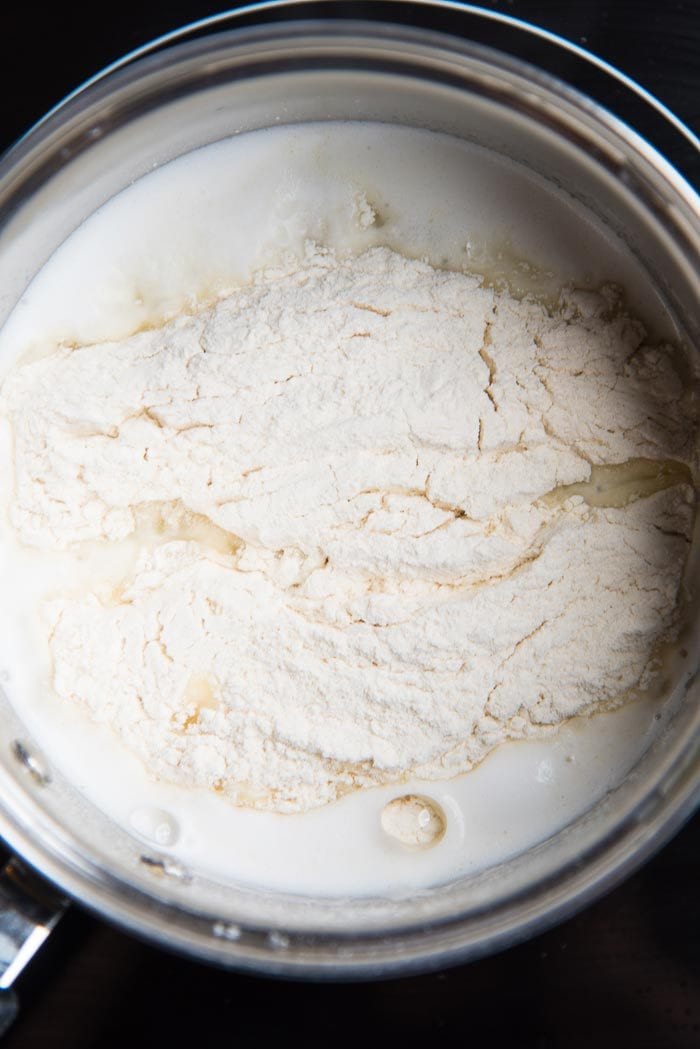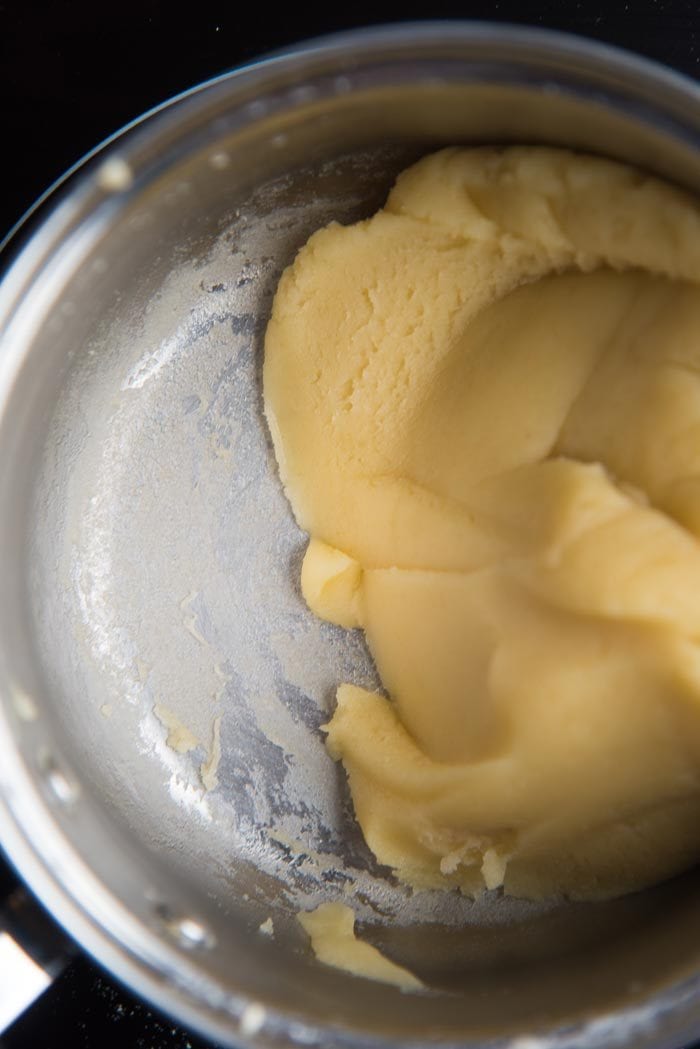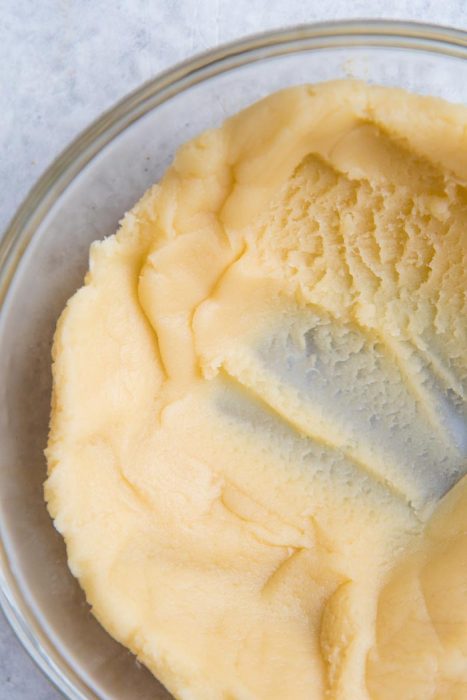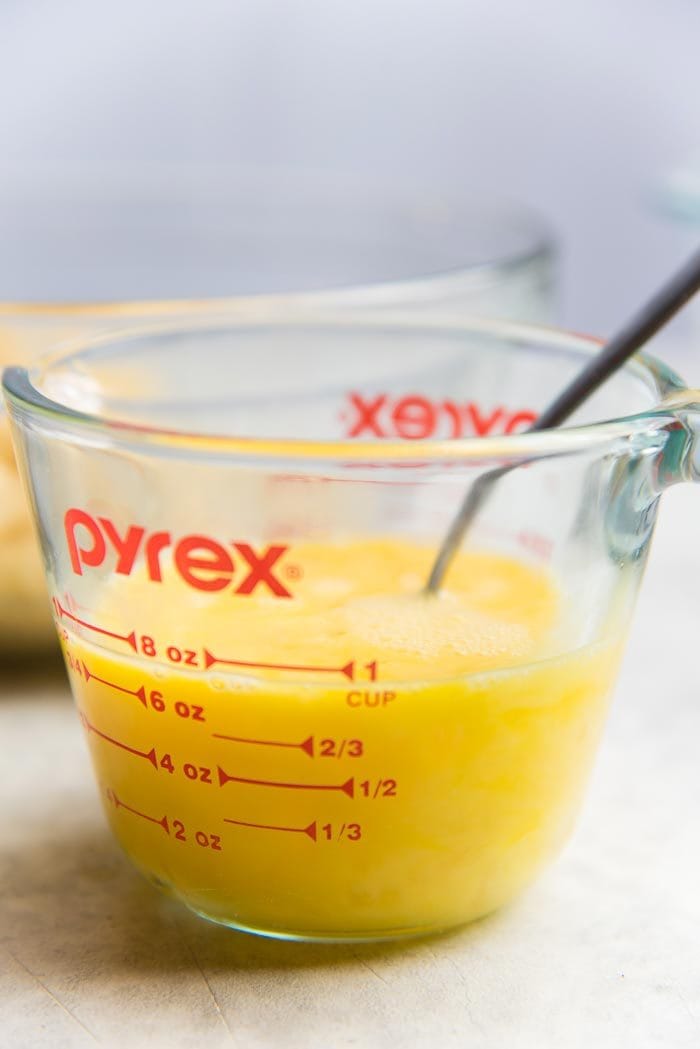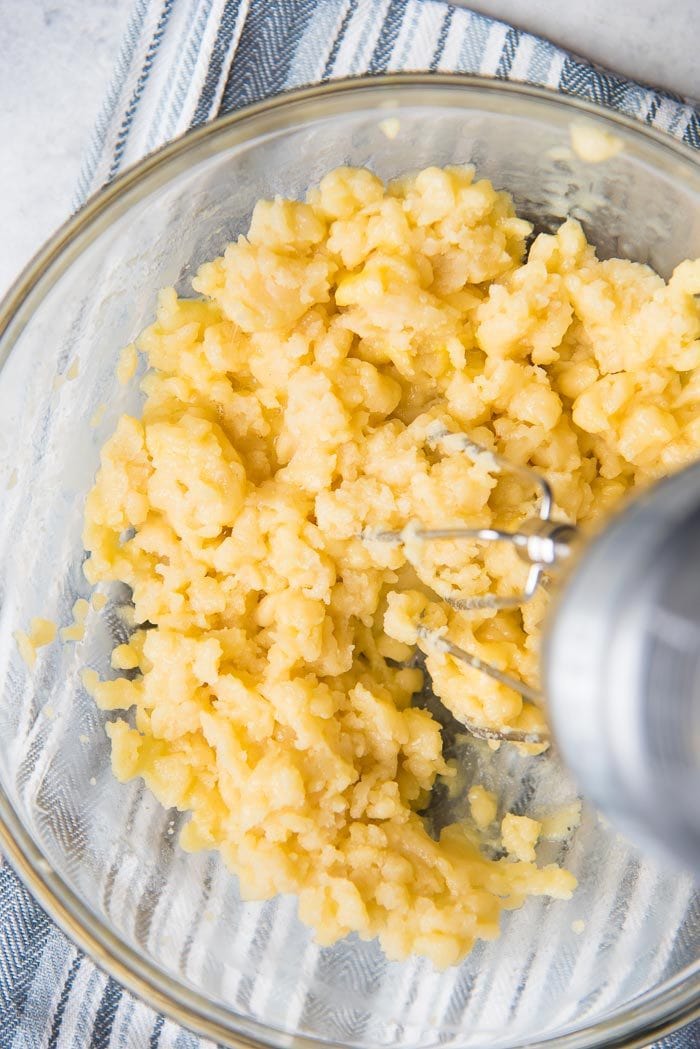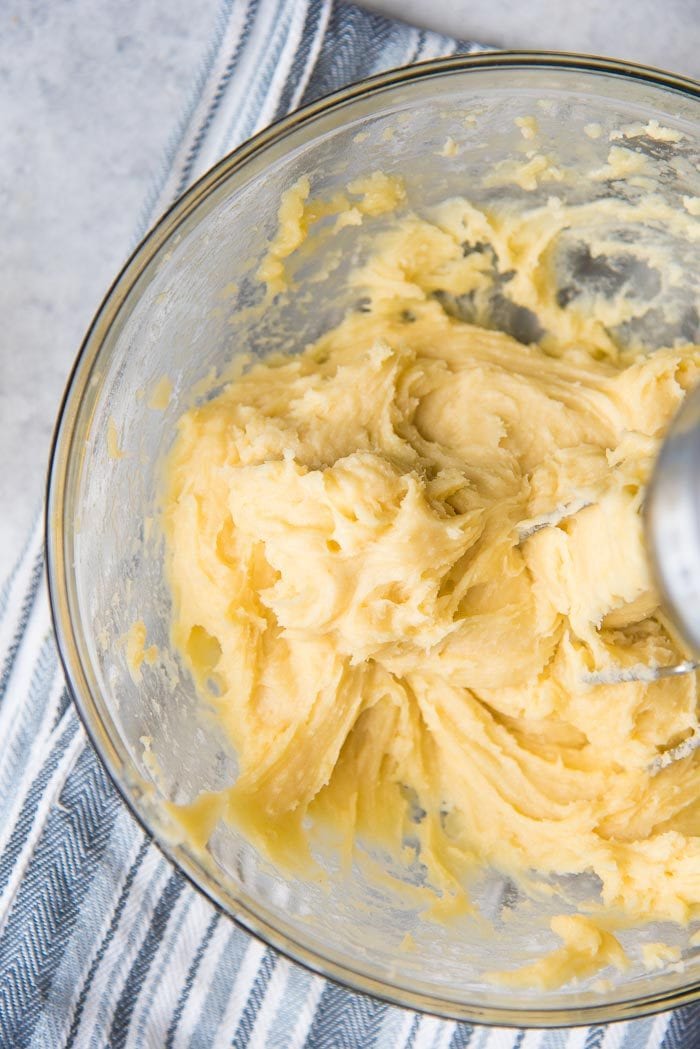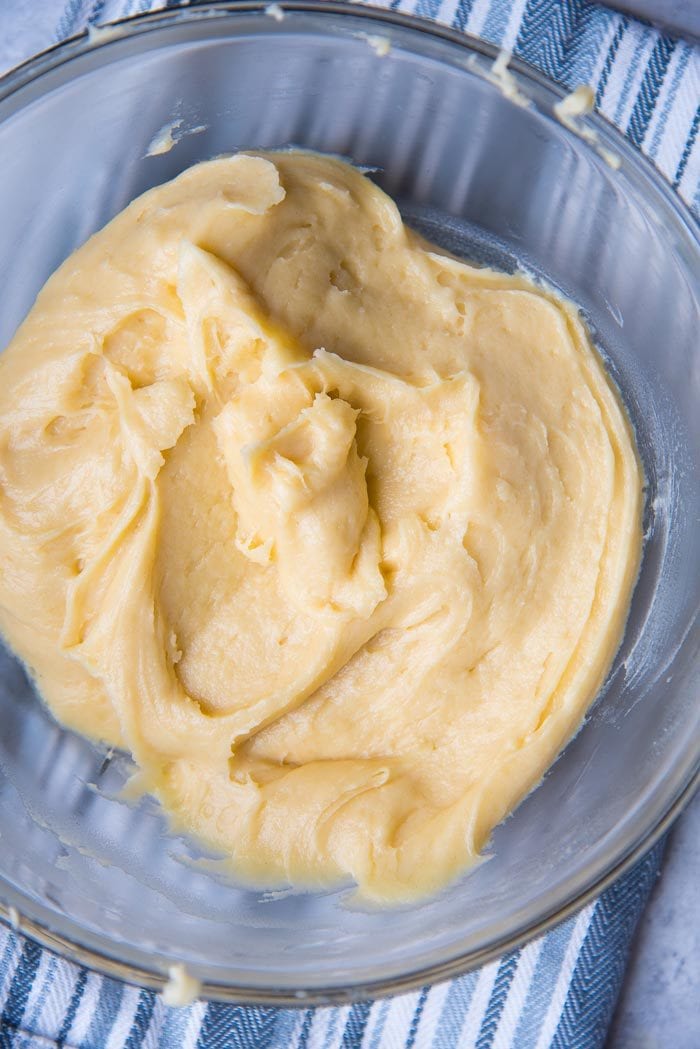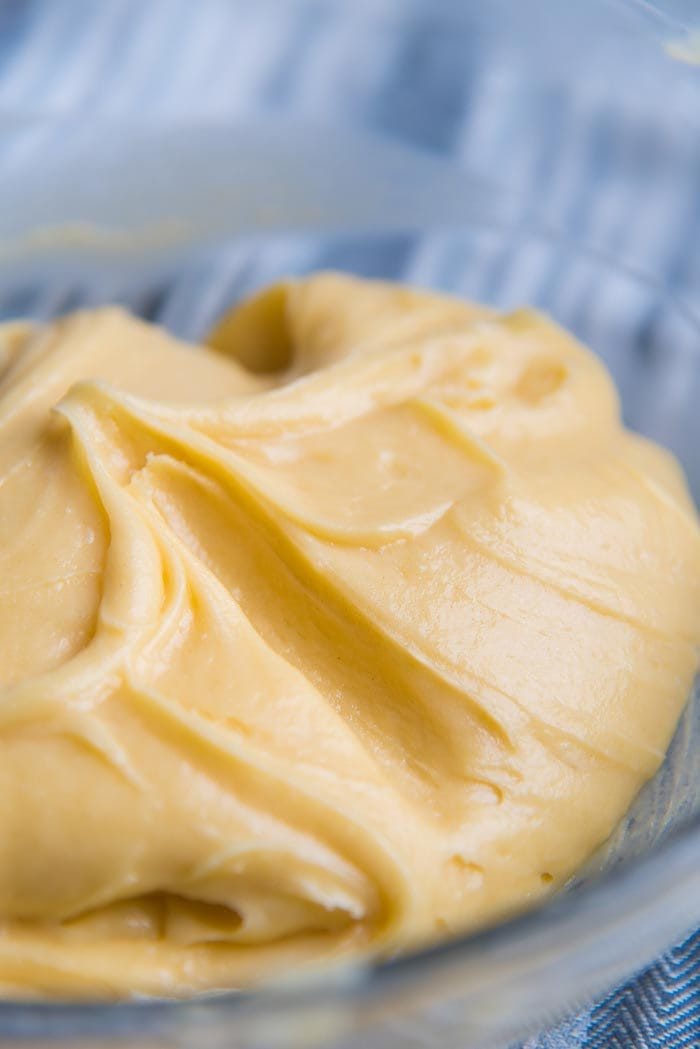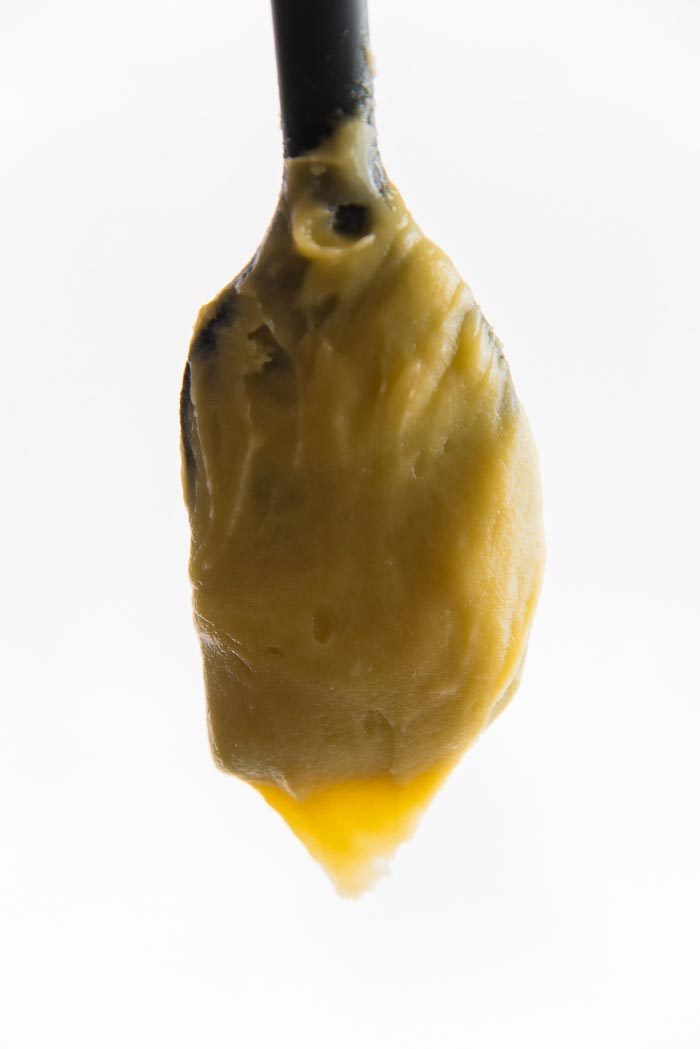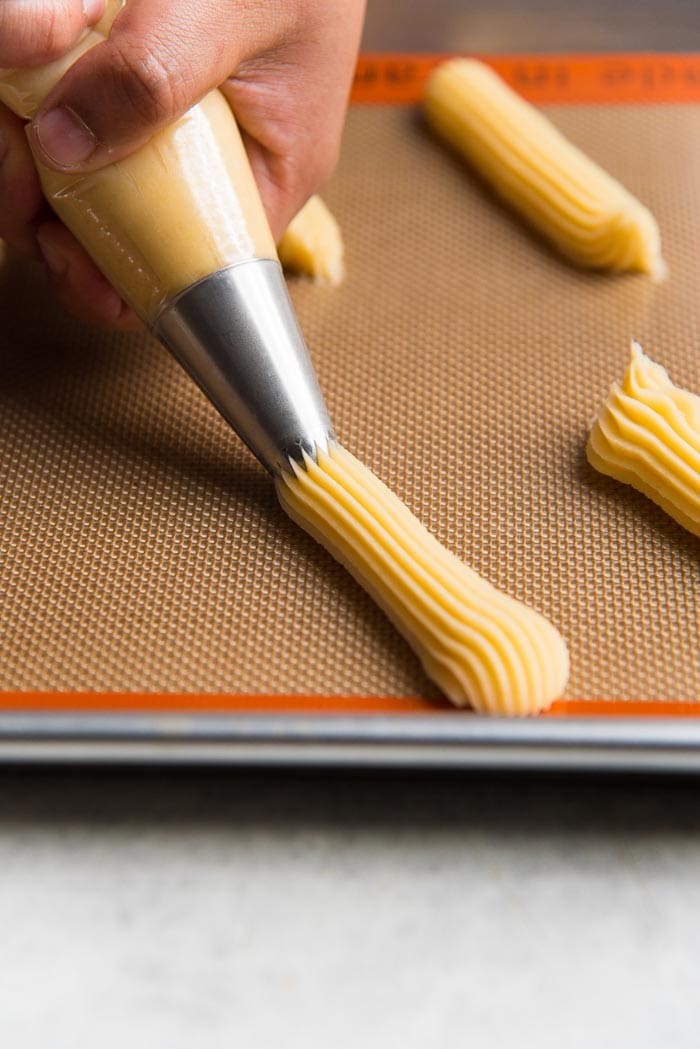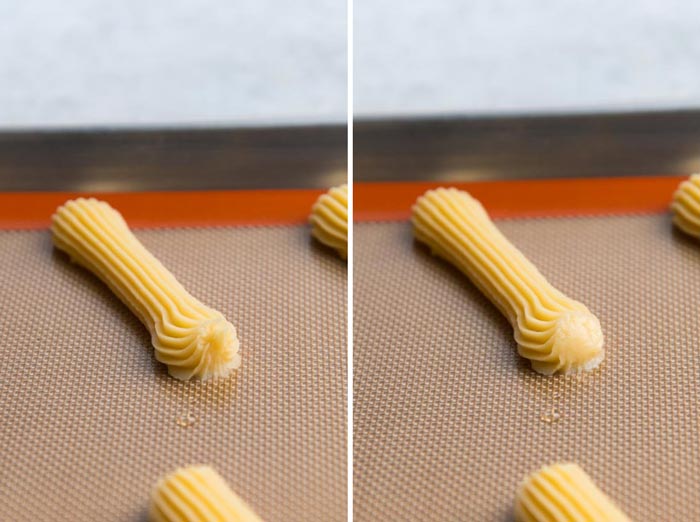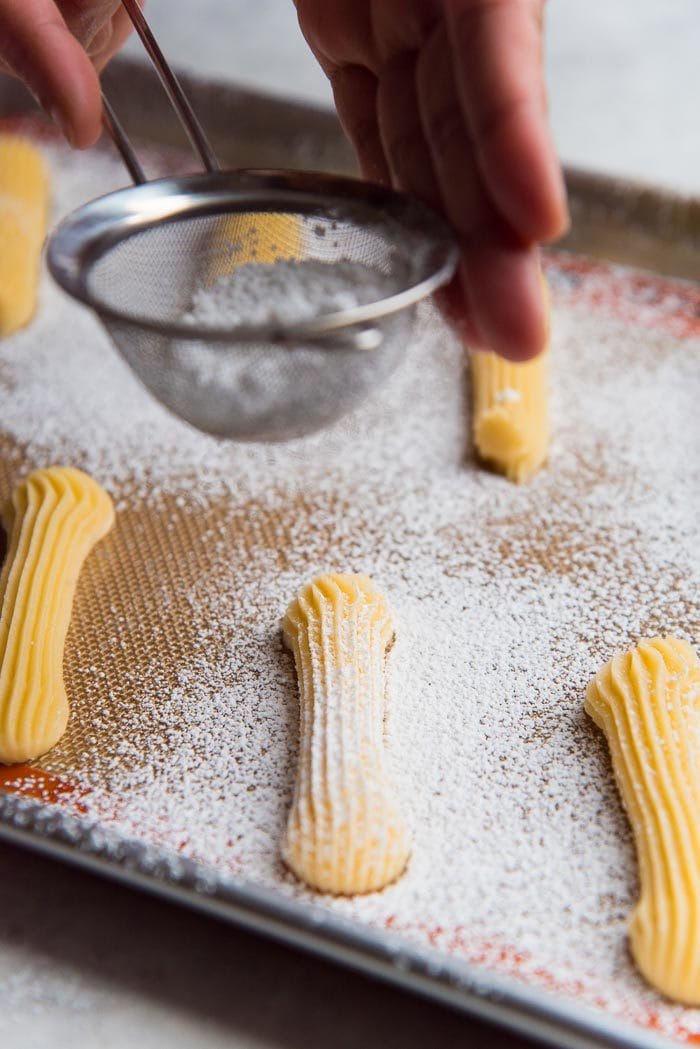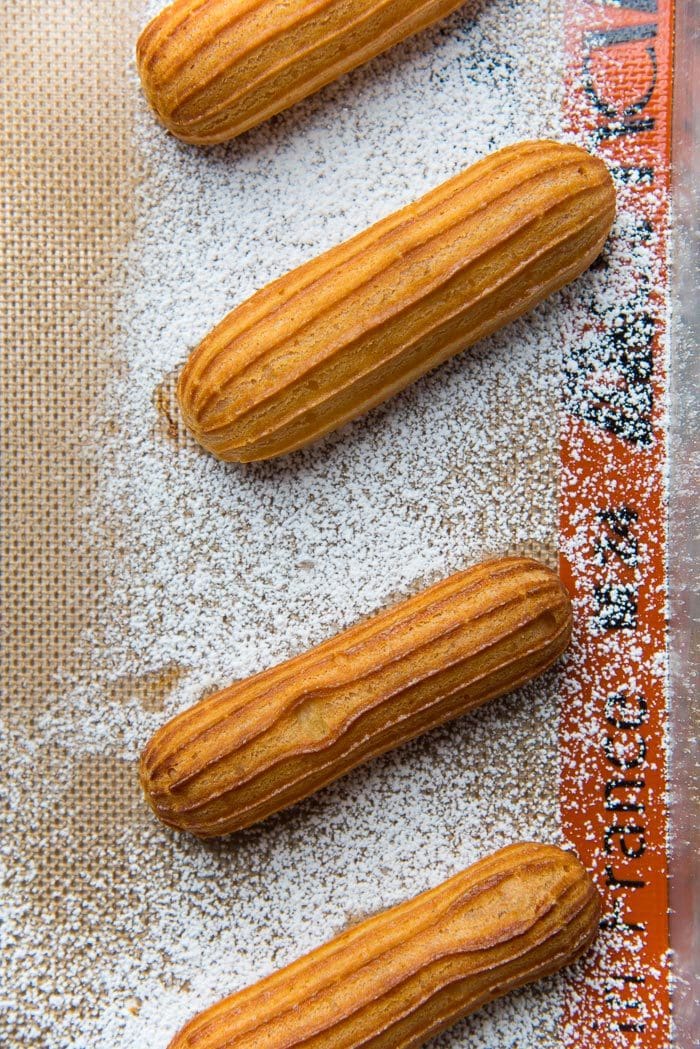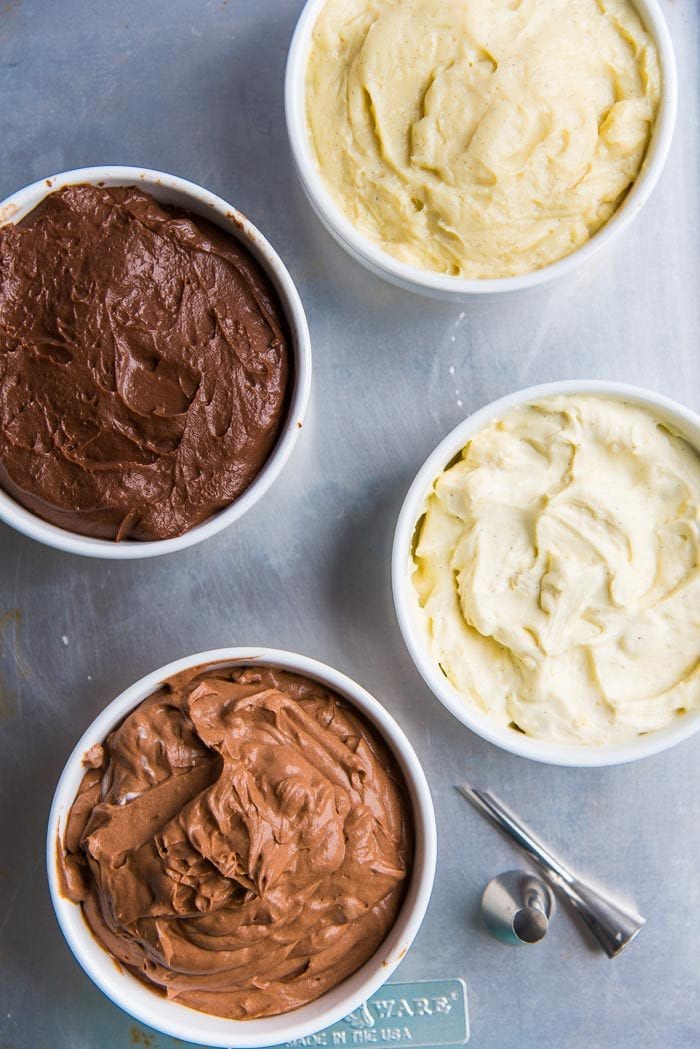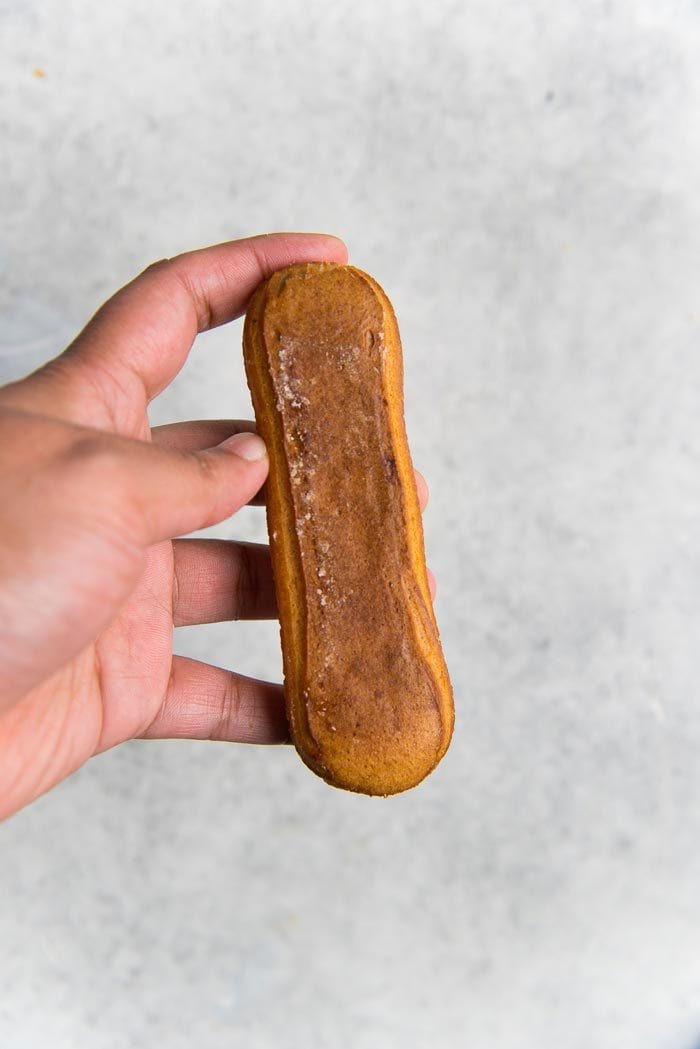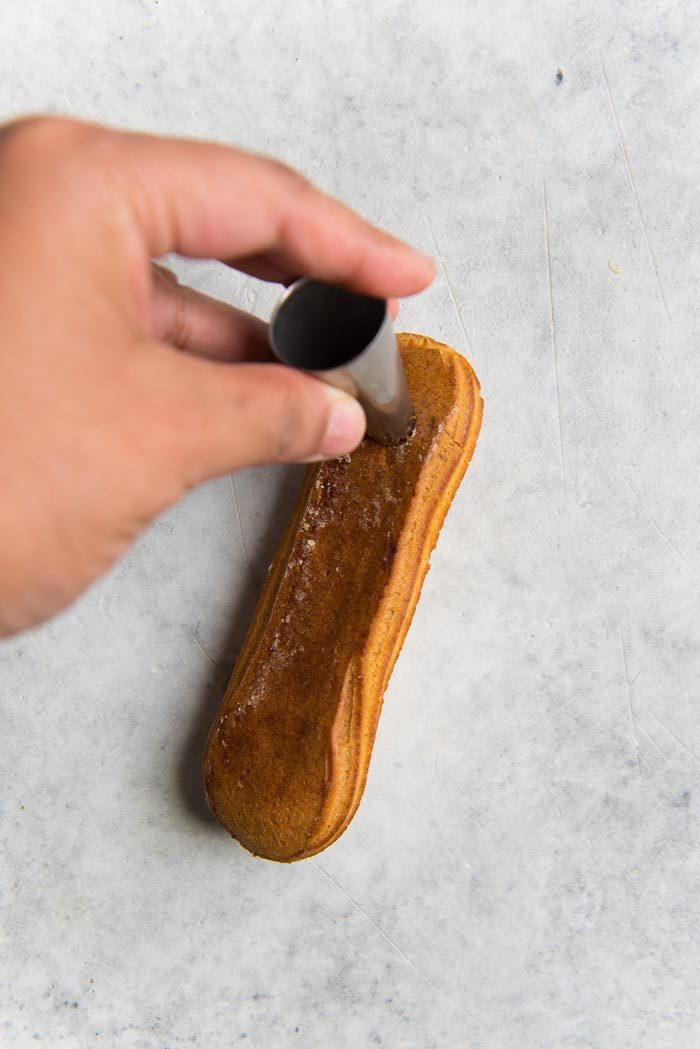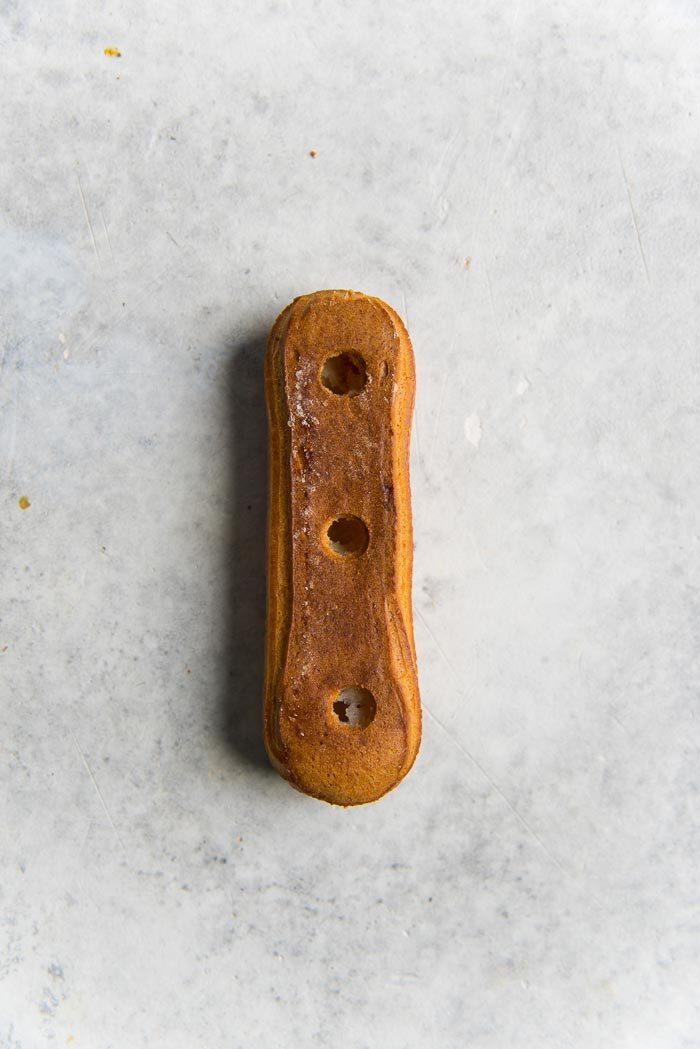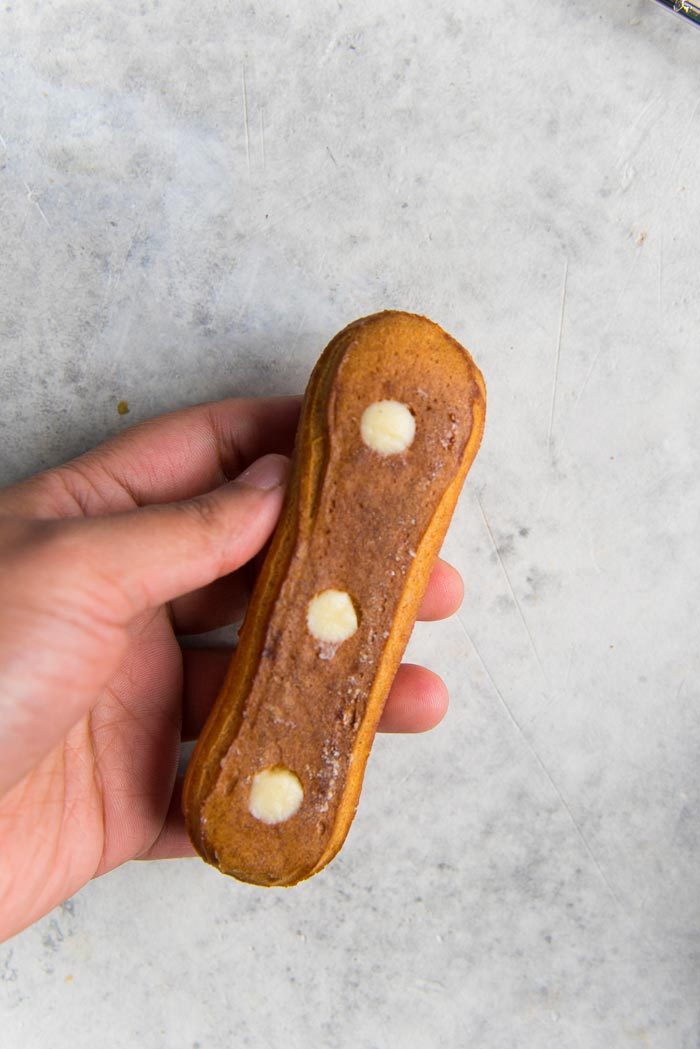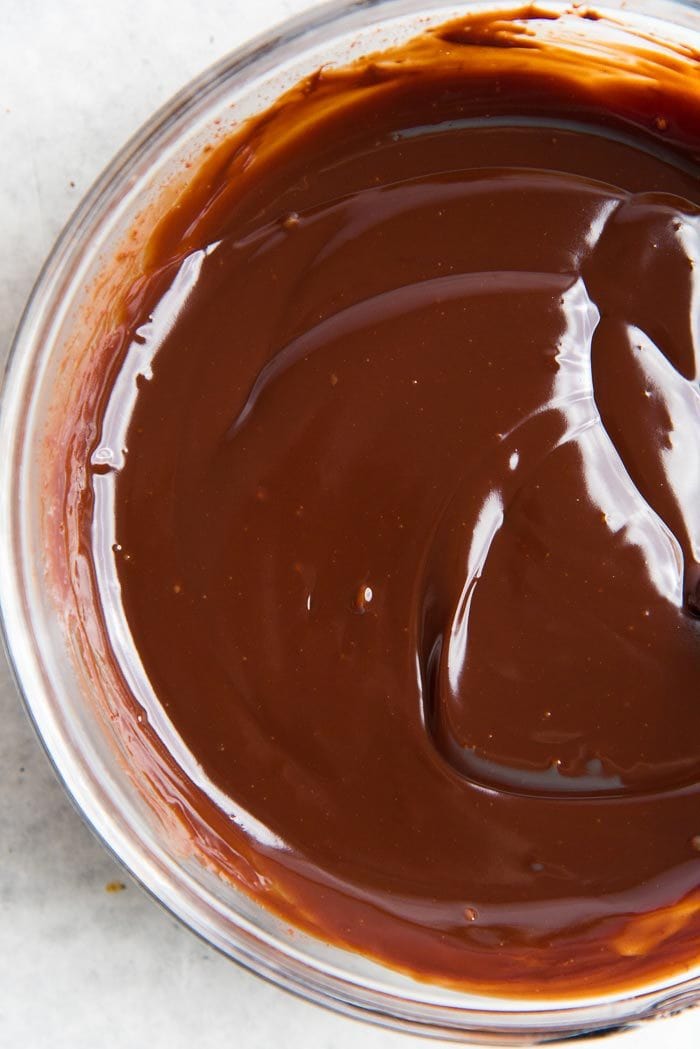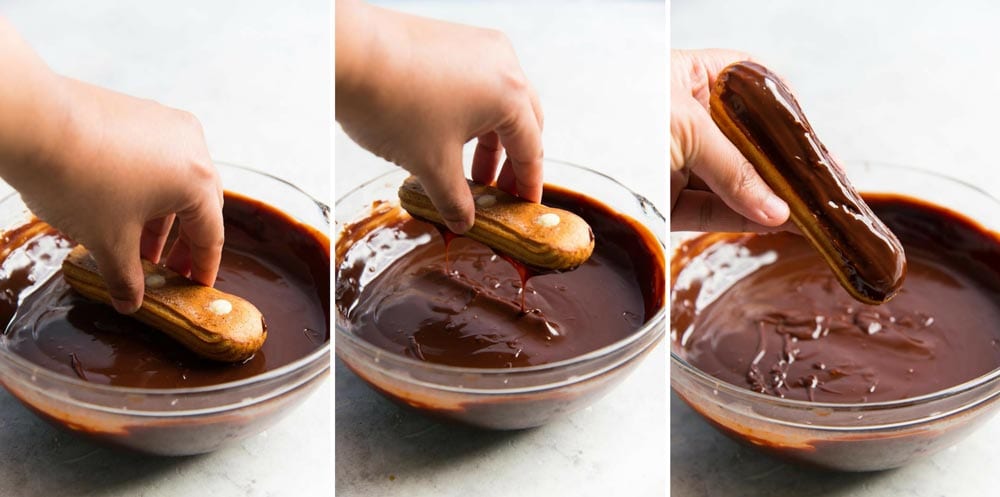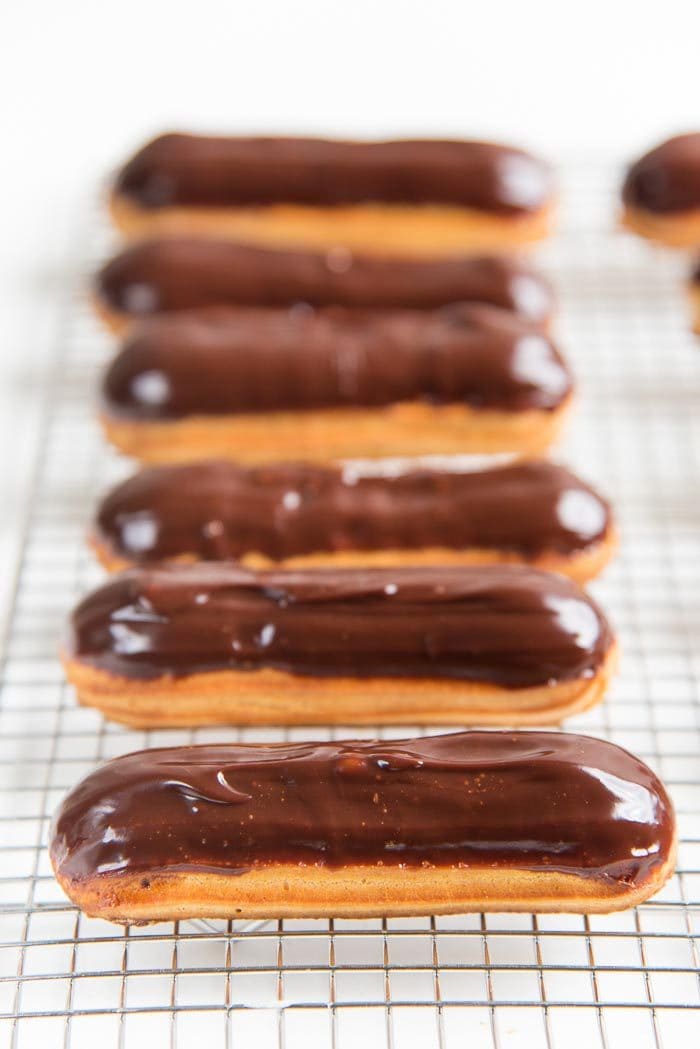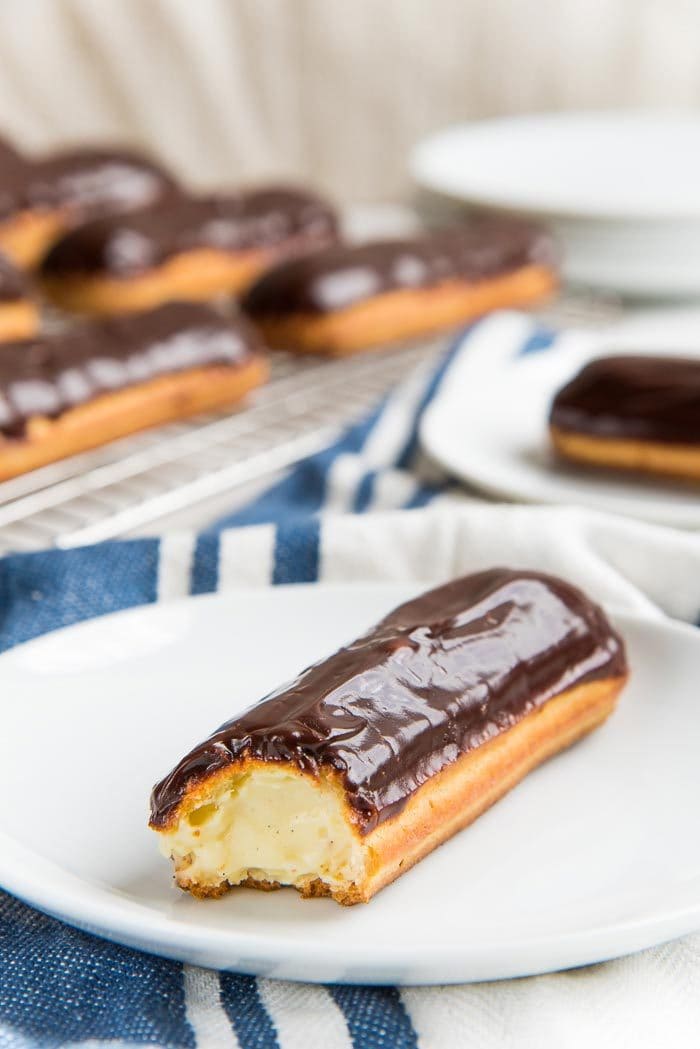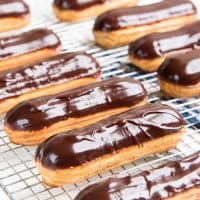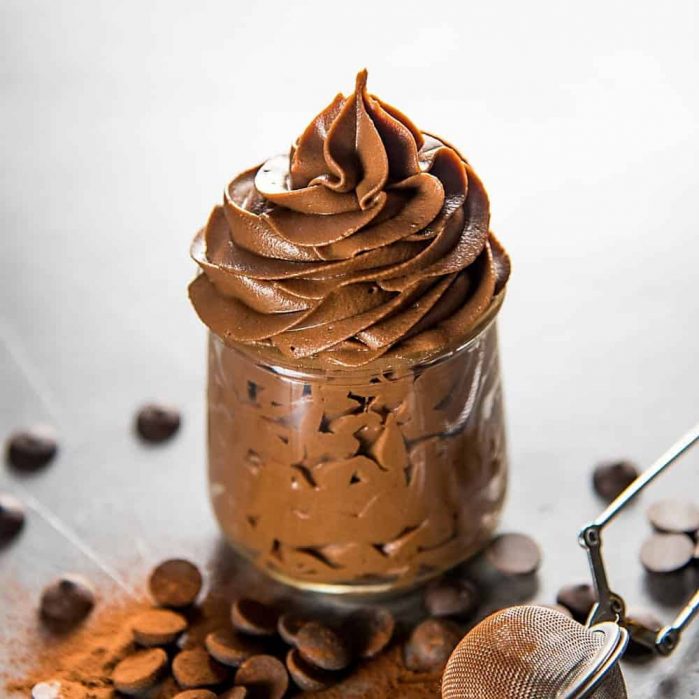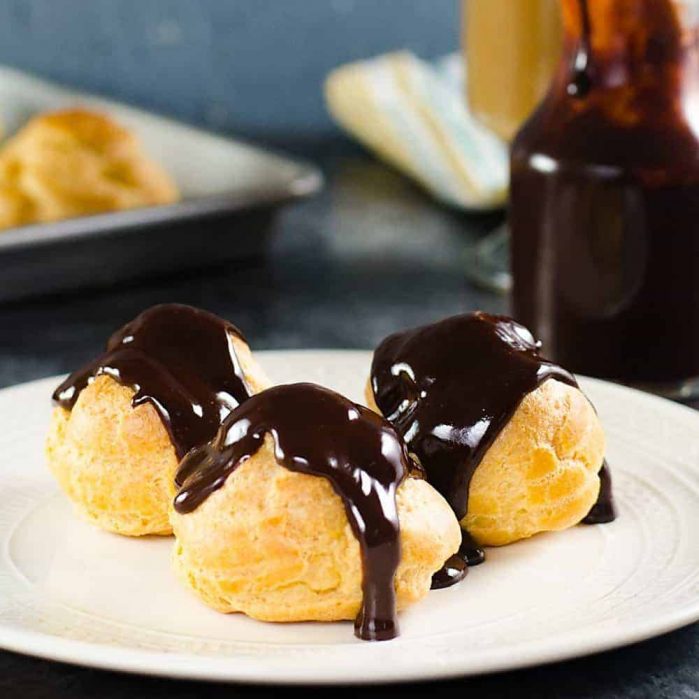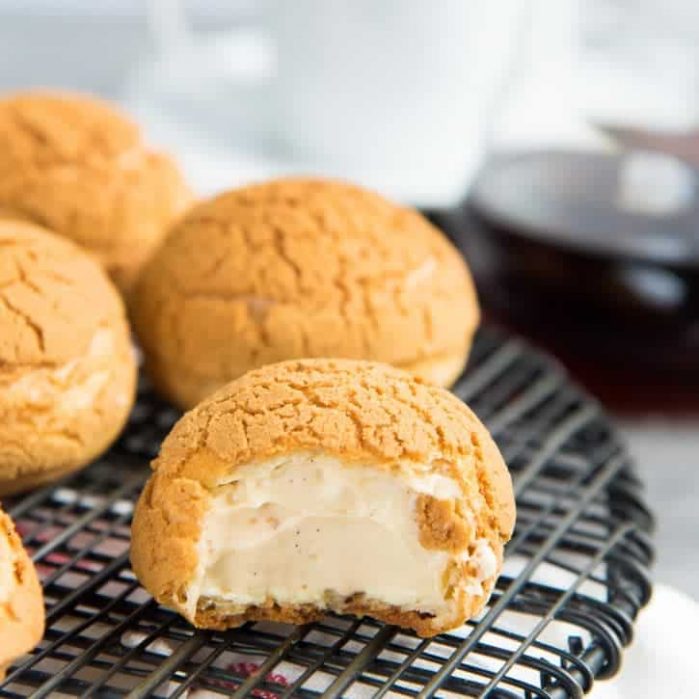Deliciously crisp, puffy, and perfect chocolate eclairs filled with chocolate or vanilla pastry cream.
Have you been left wondering why your eclairs always came out flat or soggy? Or why they have a concave-shaped bottom, or a huge crack right down the middle on the bottom? You’ve probably tried all the recipes that claim to make perfect eclairs, and still ended up with flat, depressing eclairs instead? Well, then you’ve come to the right place! 🙂 Here I’ll show you how to make failproof, perfect classic eclairs!
Why this recipe works
This is a tried and true recipe for classic eclairs that I’ve been making for over 30 years, and have perfected for home bakers so that anyone can make them! I provide all the tips and troubleshooting help to make perfect choux pastry dough, so that your eclairs are not flat and soggy, or do not have a sunken bottom or a crack on top! Lots of tips on the best way (and best piping tips) to pipe choux pastry dough for your classic eclairs, so that the end product is consistently perfect. I also provide lots of helpful tips on baking these eclairs to ensure perfect results. A lot of these tips can only come from having baked these SO.MANY.TIMES! All the tips to make delicious creamy pastry cream to fill your éclair shells are also covered, including a variety of options for different flavored and textured fillings. I also show you how to perfect the chocolate glaze and how to properly fill the éclair shells. There’s also a timeline provided on making classic eclairs that will be helpful for beginner bakers.
What is choux pastry?
My classic choux pastry troubleshooting post is one of the most popular posts on my blog, and I’ve had many readers ask me for a follow up post dedicated to classic eclairs. It’s been a long time coming, but here it is. However, I do encourage you to read my choux pastry troubleshooting recipe post first for a detailed and comprehensive guide on how to make perfect choux pastry and how to fix any shortcomings with the dough. It’ll help you troubleshoot common issues that you may encounter when making eclairs or any choux pastry dessert.
What is the difference between an éclair and a cream puff?
The main difference is the shape of the piped choux pastry. With classic eclairs, choux pastry is piped into long shapes that form long, cylindrical shells when baked. However, choux pastry is piped into smaller round mounds to make cream puffs. Another difference is that eclairs have a thicker, sturdier shell. They do not necessarily have to puff as much as for a cream puff as well. Cream puffs can also have a thick shell, but can also be much lighter than an eclair.
Pro tips for making choux pastry
The consistency of your choux pastry dough is key! Always WEIGH your ingredients, rather than relying on cup/volume measurements for guaranteed, consistent results. If you do use cups however, pay extra attention to the consistency of the dough at each step to make sure you’re on the right track. There are key signs to look for at each step of making choux pastry, before you proceed to the next step. The more you make choux pastry, the more you will be able to “read” your dough and follow these signs intuitively. If you’re new to making choux pastry, then how about starting with profiteroles or cream puffs first? These are easier and more forgiving than classic eclairs, and I’ve got two excellent recipes for making profiteroles and cream puffs. Having said that, I’m going to share with you here all my tips on making PERFECT eclairs that are nice and puffy, with a beautiful shell and with no cracks. This will help you make foolproof classic eclairs that look like they came from a high-end pastry shop! 🙂 So let’s get to it.
Common éclair fails and troubleshooting tips
Let’s start with some common eclair fails that you’d potentially encounter when making classic eclairs.
My eclairs are flat and soggy
This happens if your choux pastry dough is too runny (with too much water, eggs, or both). Or you opened the oven too early while baking, causing steam to escape, which makes the eclair shells collapse. Or you didn’t bake them long enough.
Solution
Keep an eye on the dough, and make sure you don’t add too many eggs. Never open the oven door before the 25 minute mark, to avoid letting out steam from the oven. Prick or cut the shell towards the end of the baking time (or soon after they are baked) to let steam escape as the pastry cools down.
Never add raw flour to your choux pastry to “fix” runny dough. See the post here to find out how to fix runny choux pastry dough.
My eclairs have a sunken bottom, and sometimes there’s a large crack on the bottom as well
This happens due to a combination of the reasons stated above. But in addition, your chocolate eclairs can also sink in at the bottom if the pastry case isn’t sturdy enough to hold its shape. This is not so much of an issue with profiteroles. This is because the shape of a profiterole is inherently sturdier than that of classic eclairs. For profiteroles, the contact point of the pastry with the baking sheet is wider, so it has a more stable base to bake on and rise to form a nice, airy pastry shell. There’s less risk of collapsed pastry shells here. For eclairs, the contact point with the baking sheet is less (in terms of the width of the pastry shell). So as they pastry shell expands when baking, it becomes less stable/sturdy and tends to collapse around the base, causing your eclair shells to have a concave-shaped collapsed bottom.
Solution
Use a silpat instead of parchment paper (explained in detail below). Pipe at a 45° angle, while exerting constant pressure, when you’re piping the middle of the eclair. Make sure the middle of your piped eclair is NOT thicker than the two ends (i.e. a little extra thickness at the ends, or it should be dog bone-shaped).
Silpat vs parchment paper
I came about this little discovery quite by accident. I’m not entirely sure what it is about a silpat (besides it having something to do with heat conduction), but eclairs baked on a silpat are always more stable and neat than those baked on parchment paper. If you don’t have a silpat, that is OK, you can still use parchment paper. But I usually add fewer eggs to my choux pastry dough if I know I’m baking chocolate eclairs on parchment paper.
Piping at a 45 degree angle, on the silpat mat
This is the best angle to pipe your choux pastry at constant pressure, with minimal distortions on the piped choux. If you pipe from the top (like with profiteroles), it puts too much pressure on the choux, pushing/crushing it against the tray, and this may cause your eclairs to puff up horizontally, rather than vertically. I also like to make sure the piping tip makes contact with the silpat (at a 45° angle), as I pipe the choux. It helps to form a stable base for the eclairs, while also giving you some stability to pipe evenly, with consistent pressure.
Consistent piping pressure and shape
Inconsistent or varying piping pressure will result in lumpy eclairs that aren’t as clean or professional-looking as you’d like. This is especially more problematic if you pipe extra dough in the middle compared to the ends. The middle will then puff up more, and you’ll end up with oval-shaped eclairs that are more inclined to collapse as well. This is why it’s good to pipe just a little extra dough at the ends (i.e. dog bone-shaped). You can also pipe them nice and straight, where the ends are only slightly larger than the middle. Either way, you will end up with beautiful, even, and incredibly delicious classic eclair shells, that are guaranteed to never collapse or flatten!
My eclairs have large cracks on top
This often happens when the dough isn’t prepared properly, and you have undissolved salt or sugar in it. Another reason is baking it in a high temperature oven. You also tend to get more cracks if you pipe with a round tip instead of a star tip. This is likely because of the increased surface area that you get when piped with a star tip, which gives the choux pastry more leeway to expand. See below for differences between eclairs piped with a round tip, open star tip, and a French star tip. You can see that the French star tip yields the neatest eclair pastry shell, and the round tip eclair has an uneven shape with more cracks.
Solution
Use a French star tip (instead of a round tip). If you only have a round tip, then you can use a fork to gently scrape/mark lines on the top of your piped dough to increase the surface area. Make sure the sugar and salt are completely dissolved in the water. Do not add raw flour to the dough. Lower the oven temperature (if you’re baking at 400°F or higher), and bake for longer at a lower oven temperature (375°F) instead.
How to make classic eclairs with a detailed, step by step recipe
If you’re new to making eclairs, or you’re having trouble perfecting your chocolate eclairs, please read the post carefully. These tips will help you make absolutely perfect, beautiful eclair shells every single time! 🙂
Recommended tools for making eclairs
Half sheet baking trays – at least two. I prefer baking one tray at a time, to get consistently good results. If you do want to bake two trays at a time, that is fine too, but remember TO NOT OPEN THE OVEN BEFORE THE 25 MINUTE MARK. Silpat mats – highly recommended, especially for classic eclairs (chocolate eclairs). Provides better heat conduction, and helps the eclairs rise in an even and stable way. If you don’t have silpat mats, you can use parchment paper, but be mindful of the choux pastry consistency.French star tip (1/2 inch diameter) – the grooves in the star tip create a “raked” dough that prevents the eclair shells from cracking as they expand. You can use a round tip as well, but in that case, use a fork and drag it lightly along the surface of the piped dough to make multiple, long lines (to mimic the pattern that you’d get with a star tip). You can use an open star tip too, but a French star tip is the best option.
Making choux pastry dough
Weigh your ingredients. I use a basic kitchen scale to weigh the wet ingredients as well. I simply place the saucepan on the kitchen scale, and weigh the water, then butter, and then add the salt and sugar. You can either use just water, or milk, or a mixture of water and milk. Stir while heating to make sure the salt and sugar dissolve, and the butter dissolves BEFORE the mix comes to a boil. When the mix comes to a boil, remove the saucepan from the heat and add ALL OF THE SIFTED FLOUR in one go. Stir to bring it together and form a dough. Make sure there are no lumps in your dough, and then return the saucepan to the stove and cook the dough for about 2-3 minutes while vigorously mixing. This is important because you want the excess water to evaporate. You’ll know it’s done when there’s a film of dough forming at the bottom of your saucepan. Plus, if you stick a spoon in the dough, it should stay upright (see pictures below for reference). Allow the choux pastry dough to cool down in a large bowl, until the temperature registers at under 160°F. I spread the choux pastry dough along the wall of the bowl when doing this, so that more steam escapes and the dough cools down faster.
Addition of eggs
This part is important. Add the eggs a little at a time, until your dough just starts to get a glossy sheen. This means you may end up using all the eggs, or only a portion of it. I usually end up adding 3 1/2 eggs, or sometimes 4 (if I had to cook the dough longer, which results in a drier dough). As you mix in the eggs at the beginning, the dough will be a slimy mess, but as you incorporate more eggs, it’ll become smoother, and runnier, and start to get a sheen. Stop adding eggs as soon as the dough reaches this point where it gets a sheen (or looks a little glossy), and isn’t too runny.
How to check for the correct consistency of your choux pastry dough
There are 2 ways to check for the correct consistency of your glossy choux pastry dough. Personally, I prefer the first method, but either method is effective.
Piping choux pastry dough
When the choux pastry dough is ready, transfer it into a large pastry bag (I use a 16 inch pastry bag), with a 1/2 inch wide French star tip. If it’s easier, you can cut a 4-5 inch piece of cardboard or a wooden skewer and use that as a guide to pipe eclairs of equal length. Or you can simply eye ball it too. Pipe 4-5 inch long choux pastry cases on the prepared baking tray (with a silpat mat), leaving 2 inches of space between each. I pipe about 8-10 eclairs on each half sheet baking tray. Remember to keep the piping bag at a 45° angle as discusses above, and maintain consistent piping pressure. Make the ends of your piped choux cases slightly larger than in the middle. Finish off each piped case by gently twisting the piping tip. This helps prevent the entire piped choux case lifting up along with the piping tip. This will also create a pointed or jagged end. So using a damp finger, pat down those pointed ends of your choux cases. Dust each eclair case with confectioner’s sugar. This creates a slightly caramelized exterior that not only adds a slight sweetness, but also a delightful crunch.
Baking classic eclairs
Bake in a preheated oven for 25-30 minutes, until the choux cases have turned light brown in color. Then quickly open the oven door, and carefully prick each eclair case on one end with a toothpick to release the air inside. The eclairs should have formed a brown crust by this point. This is important, because if you prick them before the crust has formed, the choux cases will collapse. Close the oven door and bake for a further 5-10 minutes (I usually bake for a further 8 minutes), until the cases have turned darker brown in color (but not burnt!). Remove from the oven and prick the other end of your choux cases, and let them cool down completely in a draft free area. I keep it on top of the oven or near the oven, where it’s a little warmer and draft-free. This way there’s no risk of the choux cases cooling down too fast and collapsing. When the eclairs have cooled down, they are ready to be filled with your choice of filling. I typically use vanilla pastry cream, or mousseline cream, or chocolate pastry cream, or even cream diplomat for a lighter option.
What filling can I use to fill my classic eclairs with?
As mentioned above, there are several options!
Vanilla pastry cream – this is the classic option. This pastry cream is almost like a vanilla pudding, with a prominent vanilla flavor, and not too sweet. Chocolate pastry cream Classic mousseline cream (pastry cream + whipped butter that make for a rich, buttery, silky smooth filling). Vanilla diplomat cream (pastry cream + stabilized whipped cream for a lighter filling for your eclairs). Chocolate cremeux – personally, I’d say this is too rich and heavy as a filling for eclairs, however it’ll work very well as a luscious topping! Cream chantilly (sweetened whipped cream).
Here, I made FOUR different fillings for my classic chocolate eclairs.
How to fill the eclairs
You have 2 ways of filling these classic eclairs.
The second method is my favorite, even though I do own a bismarck tip as well.
Dipping chocolate eclairs in chocolate glaze
Once all the eclairs are filled, then it’s time to dip them in the chocolate glaze for chocolate eclairs. The chocolate glaze is very easy to make, and super delicious on its own. It’s just a mixture of chocolate, cream, butter, and a touch of corn syrup. The simple trick to getting beautifully glazed chocolate eclairs is to DIP them in the glaze, rather than pouring the glaze over the eclairs. Carefully and evenly dip each eclair in the warm chocolate glaze. Then gently turn it in the glaze to get an even coating. Once coated, gently shake it to allow excess chocolate glaze to drip down into the bowl again. Using a paper towel or toothpick, wipe off any excess chocolate glaze along the edges of your chocolate eclair. Then place it on a wire rack and allow the glaze to set. For best results, serve these chocolate eclairs at room temp, or chilled, right away OR within 12 hours of filling. The chocolate eclairs will lose their crispness after they’ve been filled. However, since the shells are baked till they are dark golden brown in color, they form a sturdy shell that doesn’t get soggy by the filling. But the longer you go after filling your eclairs, the softer the shells will get (but they shouldn’t get soggy even after 24 hours).
Timeline for making classic chocolate eclairs
The day before: Make 1 ½ batches of the vanilla pastry cream or chocolate pastry cream. OR make 1 batch of each, if you’d like a mix of vanilla and chocolate. You can also make the choux pastry dough on the day before as well, and store it in a pastry bag, inside an air-tight plastic container. On the day you’re serving the chocolate eclairs: Let the choux pastry dough come to room temperature. Pipe and bake the eclairs (or you can bake them ahead of time and freeze as well). While the eclairs are cooling, prepare the pastry cream by transferring it into pastry bags. Also, prepare the chocolate glaze and keep it warm. Fill the eclairs, and dip each one in the chocolate glaze as you go. Let the chocolate glaze set. Chill for a few hours if needed, and serve.
Equipment and tools I use to make eclairs
Piping bags – 16 inch piping bags for the choux pastry dough French star pastry tip with 1/2 inch opening – to pipe the eclair cases. Whisks – a good set of whisks is a must for all of your baking needs. Silicone Spatula Hand mixer or Stand Mixer – I currently use KitchenAid 2 x Silpat baking mats – highly recommended for foolproof results 2 x Half Sheet pans – having two makes it easier to bake the craquelin choux pastry. While one is baking, the other tray can cool down and be ready to pipe dough on, and then bake as soon as the other tray is out.

